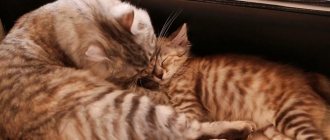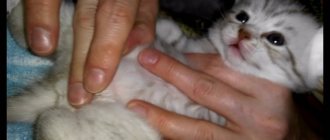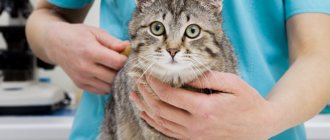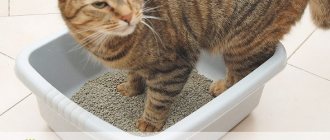Toilet for newborn kittens
For the first 2-3 weeks after lambing, the cat independently cares for the offspring and takes measures to help the cubs relieve their physiological needs. The animal licks the kittens; In this way, the abdomen is massaged, which helps remove gases, facilitate urination and defecation. The cat licks off all the secretions. The kitten goes to the toilet often: the daily number of times can reach 7-10.
After 3 weeks, complementary foods are introduced into the diet. If you choose it correctly, there will be no problems with digestion, the kittens will poop on their own, without outside help.
It is necessary to monitor the stool: if harmful substances do not leave the animal’s body with feces, severe poisoning is possible.
The stomach, swollen from gases and feces, becomes painful, the kitten is worried and meows a lot. It is necessary to take action if there has been no stool for 5 days.
Diagnosis of the condition
A pet with a characteristic symptom should be shown to a veterinarian who, after a clinical examination, will prescribe certain diagnostic methods. First of all, the doctor will conduct a detailed blood test, stool examination for helminths, protozoa, and occult blood.
An informative research method is the coprogram. Using this laboratory method, you can find out not only the microscopic composition, but also detect hidden blood in the feces of an animal. If necessary, a urine test will be performed. An ultrasound or X-ray examination of the abdominal organs, as well as a colonoscopy, can be used to find out why a cat poops blood.
We suggest you read: How long does pregnancy last in horses?
Toilet for one-month-old kittens
By 1 month, the intestines are fully developed, the animal relieves itself independently. Month-old kittens poop less often. The nature of the discharge also changes: it gradually becomes harder. The absence of stool should alert you. Signs of pathology may include refusal to eat, lethargy, apathy, anxiety, and abdominal pain.
By 3-4 months, cats switch completely to solid food. In this case, the feces become dense and take on a permanent shape. The number of urinations and bowel movements per day should be from 3 to 6 times. If the diet is dominated by fiber-rich foods, the amount of protein is not too high, bowel movements become more frequent, since food better stimulates intestinal motility.
By 5 months, the kitten should poop once daily.
Form
The shape of your stool can also tell you a lot about your internal health. Thin stool (resembling a pencil) should alert you. Perhaps some kind of obstruction is blocking the passage in the lower part of the intestine or there is pressure from the outside on the colon. This could be some kind of neoplasm. In this case, it is necessary to perform a colonoscopy to exclude a diagnosis such as cancer.
Hard and small feces indicate the presence of constipation. The cause may be an inadequate diet that excludes fiber. You need to eat foods high in fiber, do physical exercise, take flaxseed or psyllium husk - all this helps improve intestinal motility and ease stools.
Stool that is too soft and clings to the toilet contains too much oil. This indicates that the body does not absorb it well. You may even notice oil droplets floating. In this case, it is necessary to check the condition of the pancreas.
In small doses, mucus in the stool is normal. But if there is too much of it, it may indicate the presence of ulcerative colitis or Crohn's disease.
Why does a kitten have problems with stool?
Newborn animals have difficulty defecating if the cat does not care for them properly. Problems can also arise in cases where kittens are cared for by humans, if the owner does not follow the rules. After feeding, it is necessary to massage the belly and groin area; To do this, it is recommended to use cotton swabs with soft bristles.
Older kittens fed solid food may suffer from digestive problems for several reasons.
Severe stress can cause constipation.
If the kitten has recently been separated from its mother, moved to a new place of residence, a visit to the veterinarian, or aggression from another animal can cause severe nervous tension, due to which bowel movements will temporarily disappear. Most often, the duration of absence of stool in such a situation does not exceed 2-3 days.
Early weaning from the cat is possible.
In such a situation, the cub greatly misses its mother and lacks her company. There may be no stool for up to 4-5 days, after which the small cat must poop. The situation is considered normal. You should be wary if bowel movements do not begin even after.
Errors in diet planning.
A sudden change in diet or excessive amounts of protein foods often leads to constipation.
Constipation occurs in animals infected with helminths.
Due to parasites, the functioning of the gastrointestinal tract is disrupted, which leads to intestinal blockage and deterioration of peristalsis. At the same time, the animal constantly scratches its butt on the carpet or other rough surface and may become too restless.
Host mistakes
You can find out how often a kitten poops at 2 months by how many times it visits the litter box. But the animal does not always choose a pot to satisfy its natural needs. This may be the owner's fault. Here is a list of possible reasons:
- Late trained to use the tray. The most optimal age for this is one month. Later it will be more difficult.
- Dirty pot. If you don't clean the litter box in time and change the filler, the kitten may go somewhere else. Remember that cats are clean animals!
- Wrong place. If the litter box is in a place that scares and the kitten doesn't like, he won't go in it.
- Another tray. If you decide to change your pet's litter tray, be prepared for the fact that he may refuse to relieve himself in the new one. In this regard, cats are monogamous.
- Foreign odors. The cat may not like the smell from the potty, and therefore he will refuse to go into it. Therefore, you need to exclude all flavors and wash the tray with plain water. It is also forbidden for several animals to go into one tray.
- Don't punish. This method will not help you accustom your pet to the tray, but will only instill fear of the owner.
- Doesn't shit where he eats. If your pet has chosen another place as a toilet, make his dining room there, after washing everything with odor eliminating products.
- Health problems. If you follow all the rules, but the kitten still shits in the wrong place, you should contact a veterinarian.
How to deal with the problem of constipation in a kitten at home?
First you need to determine the cause of the problem.
Diet changes may be required. It is recommended to consult with the breeder to find out what food is best for your chosen breed.
A light massage in the abdominal area is recommended. The kitten's abdomen should be massaged with light circular movements. You cannot press or use force: this can seriously harm the cub.
If the diet is unbalanced and there are no contraindications, the use of an enema is allowed.
Medicines may be required. You should not select them yourself; it is better to consult a veterinarian. The use of laxatives is effective.
You can add a small amount of sunflower oil to your kitten's food. Vegetable fats will act as a laxative on the cat’s body.
If all measures have been tried, but the number of times a day your kittens defecate is not normal, treatment at a veterinary clinic may be required. Sometimes surgical intervention is necessary. Possible blockage caused by foreign body entering the intestines, severe pathologies of the digestive system.
Diarrhea with vomiting
When, as a result of reflection, the contents of the stomach are thrown out through the oral cavity, we call it vomiting. It is evidence of irritation of the central nervous system - the signal came there from the stomach or intestines, most likely the problem is inflammation, which will be indicative in the presence of concomitant diarrhea.
When in doubt, you need to look at the animal carefully: coughing is different from vomiting. When coughing, the chest works, this is a rapid movement, and when vomiting, spasms of the abdominal wall are visible, the back can also arch, the action can be prolonged and repeated.
What to do for diarrhea and vomiting in kittens
First aid for diarrhea with vomiting is provided at home by the beloved owner. Vomiting greatly depletes the kitten’s strength; in combination with diarrhea, it quickly contributes to the disruption of the water-salt balance, which leads to recurrence of vomiting and loose stools, and it will not be easy to get out of the vicious circle.
The first step is to stop the vomiting. Metoclopramide with a dosage of 0.2-0.4 mg/kg helps with this; the drug can be used 3-4 times a day. This product is in the form of a solution for subcutaneous injection or tablets.
Symptomatic treatment is also carried out with tablets and solutions of ondansetron and dolasetron. Ondasetron is given twice a day at a rate of 0.5 mg/kg. Dolasetron is dosed at 0.6-1 mg/kg and given once.
Vomiting will be stopped by prochlorpromazine and chlorpromazine at a dosage of 0.1-0.5 mg/kg three times a day. Then they look for the cause of diarrhea and eliminate it by carrying out symptomatic therapy.
Preventing constipation in kittens
You need to avoid excess protein, select high-quality dry food, or prepare your own food so that it is balanced. The first weeks after the move, you should give the same food that the cat is accustomed to from the breeder. Babies fed on natural food should not be suddenly switched to dry food. Cats go to the toilet more often if they have enough fiber in their diet. The animal should always have access to clean water.
Active games with your pet will be beneficial. You don't want your cat to become too passive. To interest your pet, you should buy different toys.
Small objects should not reach the cat. If there is a child at home who scatters small beads and toys, you should clean up what is scattered after him. Objects can become lodged in the intestines, causing partial or complete blockages that sometimes result in the death of the pet.
It is recommended to regularly show the animal to a veterinarian. Examinations will help detect pathologies in the early stages and take timely measures.
All information posted on the site is provided in accordance with the User Agreement and is not a direct instruction to action. We strongly recommend that before using any product, you must obtain a face-to-face consultation at an accredited veterinary clinic.
Diagnostic features
To find out why a cat has blood in its stool, a veterinarian performs a diagnosis. The procedure involves the use of different techniques, but first of all, blood is taken for a detailed analysis. It is also necessary to submit your pet’s stool to be examined for protozoan microorganisms and helminths, as well as to detect internal bleeding.
A laboratory method called coprogram is highly informative at the stage of diagnosing diseases in cats. With its help, you can find out what microscopic composition the blood in cat feces has, as well as identify hidden bleeding. Additional tests performed when blood is detected in a cat's stool:
- Analysis of urine;
- Ultrasound of the abdominal organs;
- X-ray of the abdominal organs;
- colonoscopy examination.
A set of diagnostic procedures allows the veterinarian to make the correct diagnosis and create an effective treatment regimen.











